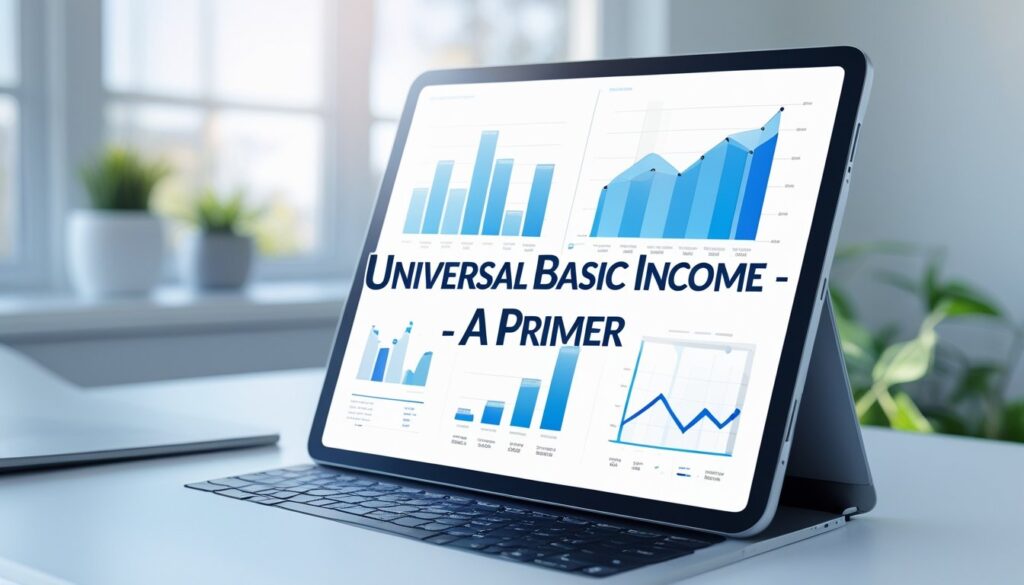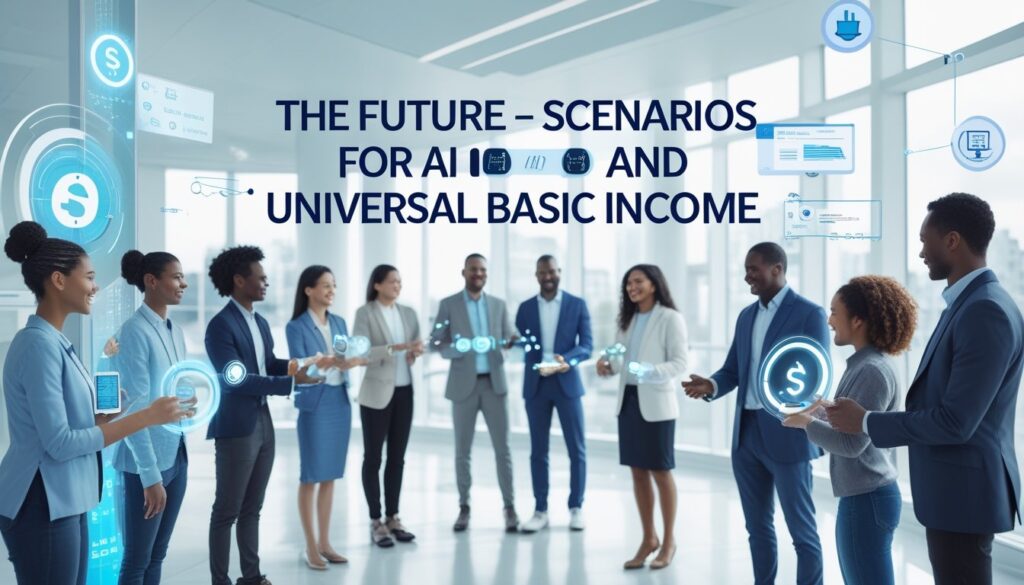Explore the critical link between AI and Universal Basic Income (UBI). This 7000-word guide examines how AI-driven job displacement makes UBI an economic necessity, its feasibility, models, and the future of human dignity in an automated world.

The Two Great Forces of the 21st Century
Two powerful, seemingly independent trends are accelerating toward a collision that will define the future of human society. The first is the rapid, relentless advancement of Artificial Intelligence, a force of automation and cognitive augmentation unlike any that has come before. The second is an old idea, perennially debated but never fully realized on a large scale: Universal Basic Income (UBI)—a periodic, unconditional cash payment given to all citizens.
For decades, UBI was a speculative thought experiment discussed in academic circles and trialed in small communities. Today, it is being thrust into the center of mainstream economic and political discourse by the sheer force of AI-driven technological change. The relationship between AI and Universal Basic Income is no longer a theoretical curiosity; it is becoming a practical, and perhaps necessary, framework for navigating the coming transformation of work, wealth, and human purpose.
This 7,000-word article will dissect this pivotal relationship. We will explore the compelling economic argument for UBI as a response to AI-driven job displacement, dissect the psychological and social implications of a world without traditional work, analyze the practical models for funding and implementation, and confront the powerful objections to this radical idea. The conversation about AI and Universal Basic Income is, at its core, a conversation about the kind of future we want to build: one of widespread destitution and instability, or one of shared prosperity and human flourishing in an age of intelligent machines.
Part 1: The Great Disruption – Why AI Changes Everything
To understand the urgency behind the AI and Universal Basic Income debate, we must first move beyond the hype and grasp the fundamental ways in which AI-driven automation differs from previous technological revolutions.
1.1 The Fourth Industrial Revolution: A Difference in Kind, Not Degree
History has seen waves of automation. The Industrial Revolution mechanized manual labor, displacing artisans and farmers but creating factory jobs. The Computer Revolution automated routine information processing, displacing clerks but creating roles for programmers and analysts. Each time, new jobs emerged that were unimaginable before.
AI-driven automation is different. It is not automating specific tasks; it is automating the core human faculty of cognition itself.
- Breadth of Impact: Previous automation was largely sector-specific. AI is a general-purpose technology, like electricity, that will transform every single industry simultaneously—from healthcare and law to art and software engineering.
- Depth of Impact: For the first time, high-skill, high-wage, knowledge-based professions are directly in the crosshairs. Radiologists, legal analysts, financial advisors, and software engineers are facing the prospect of having significant parts of their jobs automated by AI systems that can match or exceed their performance.
- Pace of Change: The speed of this disruption is unprecedented. The diffusion of new technologies is accelerating. What took generations during the Industrial Revolution may take only a decade or two with AI.
1.2 The Economic Precipice: Structural Unemployment and Underemployment
The central economic argument linking AI and Universal Basic Income is the threat of widespread, structural unemployment.
- The Displacement of Routine and Non-Routine Work: Early AI and robotics targeted routine manual and cognitive tasks. Advanced AI and robotics are now capable of non-routine tasks requiring adaptability, pattern recognition, and even limited creativity.
- The “Jobless Future” Hypothesis: Economists like Daron Acemoglu and Simon Johnson warn of a future where AI simply displaces more jobs than it creates. While new roles will emerge (e.g., AI ethicists, prompt engineers), they may be fewer in number and require a level of specialization that makes retraining a monumental challenge for the average displaced worker.
- The Devaluation of Labor: As AI becomes more capable, the economic value of human labor in many domains will decrease. This could lead to a scenario of chronic underemployment, where people are forced into a series of low-wage, precarious “gig economy” jobs, constantly competing with increasingly efficient and cheaper AI.
1.3 The Concentration of Wealth: The Winner-Takes-Most Economy
AI is a powerful capital good. Its development and ownership are highly concentrated.
- Capital vs. Labor: In an AI-saturated economy, the primary source of wealth generation shifts decisively from human labor to AI capital. The owners of the algorithms, the data, and the compute infrastructure will capture an ever-larger share of the economy’s output.
- The Rise of Superstar Firms and Tech Oligopolies: This trend is already visible. A handful of tech giants have achieved market capitalizations and profit margins that dwarf those of industrial-era corporations. As AI amplifies productivity, this concentration is likely to intensify, leading to extreme levels of wealth and income inequality that could destabilize democracies and erode social cohesion.
This creates a powerful economic rationale for UBI: it acts as a mechanism to distribute the immense productivity gains generated by AI capital back to the population at large, functioning as a dividend for being a citizen and stakeholder in a society that is being radically transformed by technology.
Part 2: Universal Basic Income – A Primer

Before analyzing the link, we must define UBI clearly and dispel common misconceptions.
2.1 The Core Principles of UBI
A true Universal Basic Income has three defining characteristics:
- Universal: It is paid to all individuals, regardless of income, employment status, or wealth. A billionaire receives the same payment as a person with no income.
- Unconditional: It is paid without any requirement to work, to be looking for work, or to behave in a certain way. It is a right of citizenship, not a benefit tied to compliance.
- Cash Payment: It is provided in the form of money, not vouchers or in-kind benefits (like food stamps). This preserves individual autonomy and freedom of choice, allowing recipients to spend it on what they deem most important.
2.2 UBI vs. Traditional Welfare
The universality and unconditionality of UBI are what distinguish it from traditional, means-tested welfare programs.
- Elimination of the Welfare Trap: Means-tested benefits are often reduced or withdrawn as a recipient’s income rises, creating a high effective marginal tax rate that can disincentivize work. Since UBI is universal and unconditional, it is never withdrawn, eliminating this poverty trap.
- Reduced Bureaucracy and Stigma: A simple, universal payment requires a far less complex and costly administrative apparatus than a system that must constantly verify eligibility. It also removes the stigma associated with receiving “government handouts,” as everyone receives it.
- Empowerment and Agency: By giving people cash with no strings attached, UBI trusts individuals to make their own best decisions, fostering dignity and personal responsibility.
Part 3: The Synergy – How UBI Addresses the AI Disruption
The case for AI and Universal Basic Income is built on a multi-faceted synergy. UBI is not just a Band-Aid for unemployment; it is a foundational pillar for a new social contract.
3.1 The Economic Stabilizer: A Floor for the Modern Economy
- Maintaining Aggregate Demand: Mass unemployment or underemployment leads to a collapse in consumer spending, which can trigger a deflationary spiral and deep recession. UBI acts as a perpetual economic stabilizer, ensuring a baseline of consumer demand that keeps the economy functioning, even as human labor becomes less central to production. It creates a resilient consumer base for the goods and services that AI-powered businesses produce.
- Supporting Transition and Retraining: UBI provides the financial security necessary for people to retrain, go back to school, start a business, or take time to find a good job match. It enables a more dynamic and adaptable workforce, reducing the friction of economic transition.
3.2 The Social Shock Absorber: Mitigating the Human Cost
- Dignity in a Post-Work World: For centuries, personal identity and social status have been deeply tied to one’s profession. The erosion of work could lead to a crisis of meaning, loneliness, and social unrest. UBI provides a foundation of economic security that allows people to explore other sources of meaning and contribution—caregiving, community service, art, hobbies, and lifelong learning—without the threat of destitution.
- Recognizing Unpaid Labor: UBI can be seen as a social dividend that compensates for the immense amount of unpaid but socially vital work that happens outside the formal market, such as childcare, eldercare, and volunteer work. This work will remain essential, even in a highly automated future.
3.3 The Engine of a New Renaissance: Unleashing Human Potential
This is the most optimistic argument for the AI and Universal Basic Income pairing.
- Fueling Creativity and Entrepreneurship: Financial security is a key enabler of risk-taking. With a UBI safety net, more people would have the freedom to pursue entrepreneurial ventures, artistic projects, and scientific exploration that are too risky under the current system. This could unleash a wave of human creativity and innovation, complementing the capabilities of AI.
- Creating a “Passion Economy”: UBI could facilitate a shift from a “job economy” to a “passion economy,” where people engage in work they find intrinsically meaningful, even if it is not highly remunerative in the market. This could lead to a richer, more diverse, and more fulfilling cultural and social landscape.
Part 4: The Practicalities – Models, Funding, and Implementation

The transition to a system of AI and Universal Basic Income is a monumental challenge. It requires answering the most difficult question: How do we pay for it?
4.1 Funding Mechanisms: Capturing the Value of AI
The core principle is that UBI should be funded by the productivity gains of the automation it is designed to address.
- Taxing Capital and Data:
- Robot Tax: A popular but controversial idea, a tax on the value of automated machinery and AI software. The challenge is defining what constitutes a “robot” or an “AI” for tax purposes.
- Data Dividend: Since data is the “oil” of the AI economy, a tax could be levied on the collection and use of personal data, with the revenue distributed directly to citizens as a UBI. This reframes data not as a free resource for corporations, but as a collective asset.
- Corporate Profit and Capital Gains Taxes: Significantly increasing taxes on the super-profits of highly automated companies and on capital gains, which disproportionately benefit the wealthy.
- New Models of Public Ownership:
- Sovereign Wealth Fund for AI: The state could create a sovereign wealth fund that takes an equity stake in leading AI companies (through investment or a mandate). The returns from this fund would then be distributed directly to citizens as a dividend, similar to the Alaska Permanent Fund, which pays an annual dividend to state residents from oil revenues.
- Other Proposed Mechanisms:
- Carbon Tax: Using revenue from a tax on carbon emissions to fund a UBI, simultaneously addressing climate change and economic insecurity.
- Value-Added Tax (VAT): A broad-based consumption tax, as advocated by Andrew Yang in his 2020 presidential campaign. While somewhat regressive, its combination with a UBI payment can make the overall system progressive, as the UBI payment outweighs the VAT cost for the vast majority of low- and middle-income individuals.
4.2 Implementation and Phasing
A national UBI would not be implemented overnight. A plausible path involves:
- Pilot Programs and Research: Expanding on existing small-scale pilots (like those in Finland, Kenya, and Stockton, California) to gather more robust data on impacts on health, entrepreneurship, and well-being.
- Partial UBI or “UBI-Lite”: Starting with a smaller payment, or by consolidating existing, conditional welfare programs into a single, unconditional cash payment.
- Phased Introduction: Gradually increasing the UBI amount as automation accelerates and new funding mechanisms (like a sovereign wealth fund) mature and generate revenue.
Part 5: The Case Against – Objections and Counterarguments
No policy proposal of this magnitude is without powerful objections. A honest discussion of AI and Universal Basic Income must address them head-on.
5.1 The Cost and Inflation Argument
- The Objection: “A UBI is astronomically expensive and would be wildly inflationary, eroding the purchasing power of the very payment it provides.”
- The Counterargument:
- Funding Source is Key: The objection holds if UBI is funded purely by printing money. However, if it is funded by redistributing existing wealth and productivity gains through taxes, it is largely a transfer, not a net injection of new money into the economy, which mitigates inflationary pressure.
- Productivity-Driven Deflation: AI is inherently deflationary in many sectors—it drives down the cost of goods and services. A well-calibrated UBI could offset this deflationary pressure, creating stable prices rather than hyperinflation.
5.2 The Work Disincentive Argument
- The Objection: “If you pay people for nothing, they will do nothing. It will destroy the work ethic and lead to a society of idleness.”
- The Counterargument:
- Evidence from Pilots: Data from UBI experiments consistently shows a small reduction in working hours, but this is primarily attributed to people taking more time to find better jobs, further their education, or care for family members. There is no evidence of a mass exodus from the workforce.
- Human Motivation is Complex: People work for more than just money—for status, community, purpose, and fulfillment. UBI might change the nature of work, shifting it away from unpleasant, compulsory labor and towards meaningful activity.
5.3 The “Moral Hazard” and Political Feasibility Argument
- The Objection: “It is unfair to transfer money from hard-working people to those who choose not to work. It is politically impossible to implement.”
- The Counterargument:
- Reframing as a Dividend: The narrative must shift from UBI as a “handout” to UBI as a “social dividend” or a “citizen’s share” of the technological inheritance we all collectively own and benefit from.
- Building a Broad Coalition: The political feasibility will change dramatically when large segments of the population—not just the poor, but the middle class, white-collar workers, and parents—see their economic prospects threatened by AI. UBI could become a unifying policy for a new, broad-based political coalition.
The Future – Scenarios for AI and Universal Basic Income

The path of AI and Universal Basic Income will shape our collective future. Several scenarios are possible.
Scenario 1: The Proactive Adoption – The “Shared Prosperity” Model
Society recognizes the disruptive potential of AI early and proactively implements a UBI funded by a sovereign wealth fund and taxes on automation. The result is a post-scarcity-adjacent society where AI handles most tedious labor, and humans are freed to pursue education, arts, science, and community. It is a future of widespread leisure, creativity, and psychological well-being.
Scenario 2: The Reactive Implementation – The “Social Unrest” Model
Governments ignore the warning signs until mass unemployment triggers severe social unrest and political instability. UBI is then implemented hastily as an emergency measure to quell dissent, but in a less thoughtful, more poorly funded form. It functions more as a permanent unemployment benefit in a fractured society.
Scenario 3: The Rejection – The “Fortress World” Model
The political will for UBI never materializes. Society fractures into a tiny, ultra-wealthy elite who own the AI capital and a vast, impoverished majority with no economic utility. This leads to either a permanent, surveilled welfare state for the masses or widespread social collapse. This is the dystopian outcome that advocates of AI and Universal Basic Income seek to avoid.
Epilogue: A Choice of Civilizations
The debate around AI and Universal Basic Income is about more than economics; it is a debate about human values. It forces us to ask: Does human dignity and the right to a decent life depend on one’s economic output? In a world where machines can produce abundance, will we choose to share that abundance, or will we hoard it?
AI gives us the means to eliminate poverty and toil. UBI provides a potential mechanism to distribute that freedom. The partnership between AI and Universal Basic Income represents a conscious choice to build a human-centric future, where technology serves to liberate rather than subjugate, and where the purpose of life is not merely to survive, but to thrive. The algorithms are being written. The question is, what values will we encode into our society? The time to decide is now.
